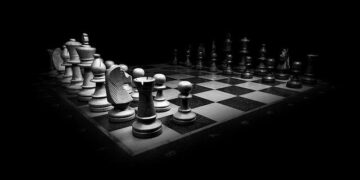ByNeil Kagan andStephen Hyslop
Published September 21, 2023
• 9 min read
Most of the fighting during World War II took place overseas, destroying much of Europe and Pacific nations in the process. But there are little known instances of Japan and Nazi Germany attacking the American mainland. These incidents—including balloon bombs, lurking U-boats, and a mysterious object flying in Los Angeles’s night sky—highlighted the vulnerability of the U.S. homeland and prompted increased defense measures. They also unleashed fear and suspicion throughout the American population, notably against Japanese Americans, resulting in the internment of thousands of innocent people. Here are some notable examples of enemy attack on U.S. soil while war raged abroad.
(Japan had little chance of victory—so why did it attack Pearl Harbor?)
Japanese balloon bombs
Between November 1944 and April 1945, the Japanese launched about 9,000 high-altitude balloon bombs, known as “fire balloons,” that were carried across the Pacific Ocean in the atmospheric jet stream with the aim of starting forest fires in the western United States. The balloons were kept afloat using a mechanism that triggered a fuse when the balloon dropped in altitude, releasing a sandbag to lighten the load and rise back up; this was repeated until all that was left was the bomb. While there have been only 300 documented recoveries, some of these balloons reached as far inland as Wyoming and Montana.
One had tragic results. On May 5, 1945, a balloon bomb exploded near Bly, Oregon, killing six Americans on a church picnic, including a pregnant woman and five children—the only mainland casualties that resulted from enemy action during World War II. While the Japanese hoped to instill panic and divert resources from the war effort, the U.S. government kept the enemy’s scheme under wraps from the public for fear of mass hysteria. Even the affected community was forced to remain silent after the disastrous event.
The German U-boat threat
German U-boats—an abbreviation of Unterseeboot, the German word for “undersea boat”—prowled the Atlantic waters along the American and Canadian coastlines between January and June 1942, targeting U.S. and Allied shipping. In the first three months of 1942, they sank more than 100 ships—some within sight of land. In North Carolina alone, U-boats sank 78 merchant ships, killing 1,200 merchant marines.
The U.S. Navy was not prepared for this threat, and the situation became so desperate that unarmed civilian light aircraft patrolled offshore, though the pilots had no means of driving the U-boats from the U.S. coastline. Some crews later jury-rigged their planes with bombs, successfully sinking two U-boats.
The attacks finally declined after American merchant ships began sailing in transatlantic convoys, accompanied by sea and air escorts.
(Wreck of fabled WWI German U-boat found off Virginia.)
A skulking Japanese submarine
On February 23, 1942, a Japanese submarine, the I-17, under the command of Commander Nishino Kozo surfaced off the coast of California and shelled the Ellwood oil field near Santa Barbara. It was one of California’s largest oil fields, but unlike those in San Francisco and Los Angeles, it did not have a major military presence.
Contemporary newspaper reports describe the attack as beginning at 7:15 p.m., with a total of about 16 shells fired. Hilda Wheeler, who helped run the nearby Wheeler Inn, described the scene: “We saw the shells tearing up the ground as they landed between us and the ocean front. … We all thought at first it was target practice. And then we looked out back and saw the earth spurting up and we were scared to death.”
Amazingly, the only destruction was a damaged rig that needed a $500 repair job, and one man was wounded when he attempted to defuse an unexploded shell. U.S. planes chased the sub, but Nishino got away.
Nevertheless, the incident generated significant fears of invasion among Americans living on the West Coast. Newspapers blurted: “Submarine Shells Ellwood Oilfield” and “First Attack of War on Continental U.S.” Soon after, the U.S. government unjustly rounded up more than 120,000 Japanese Americans—the majority U.S. citizens—and placed them in internment camps, where they remained until 1945.
(How did a Japanese WWII submarine end up in Texas?)
A mysterious flying object
The day after the Ellsworth oilfield was attacked, paranoia reigned, leading to one of the war’s most bizarre home-front incidents. Naval intelligence told units on the California coast to prepare for a potential Japanese attack. At 2 a.m. on February 25, the military picked up an unidentified flying object approaching the Los Angeles area. Believing the Japanese might use aircraft or balloons to launch an attack on California, they sounded air raid sirens, and the city went into a state of high alert. Searchlights aimed at the object and more than 1,400 rounds of anti-aircraft ammunition were fired, resulting in a chaotic night-sky scene. During the chaos, several people died as a result of car accidents and heart attacks. But no enemy aircraft was shot down, and no wreckage or debris was recovered.
This event, referred to today as the Battle of Los Angeles, remains shrouded in mystery, with no definitive explanation for the mystifying object.
(How street fashion sparked a WWII race riot in Los Angeles.)
A bomb-equipped floatplane
On September 9, 1942, a Japanese submarine launched a small reconnaissance floatplane equipped with two 170-pound thermite incendiary bombs over the Oregon coast in the hope of starting massive forest fires and igniting large-scale panic. The pilot, Nobuo Fujita, released the bombs about 50 miles inland in the vicinity of Mount Emily, starting a smattering of small forest fires. Rainfall in the area made the forest damp and less prone to igniting. Bomb fragments identified as Japanese were collected and handed over to the U.S. Army.
President Roosevelt called for a news blackout in the hopes of avoiding mass panic, though the effort proved fruitless since so many people already knew about the attack. The military brought in fighter aircraft, and blackouts were implemented all along the West Coast.
Fujita conducted another incendiary attack after midnight on September 29, 1942, dropping more two bombs along the Oregon coast. He reported seeing flames, but no one on the ground reported anything.
(These 5 female spies helped win World War II.)
Unjust internment
Japanese Americans had long faced bias in the U.S., where further immigration from Japan and other Asian nations was barred in 1924. After war erupted in the Pacific, Earl Warren—the attorney general of California and future chief justice of the U.S. Supreme Court—called for interning those of Japanese ancestry living on the West Coast (two-thirds of whom were U.S. citizens), a drastic step that President Roosevelt authorized in early 1942.
Some 120,000 Japanese Americans were given between four days and two weeks to settle their affairs, gather their belongings, and be moved to inland prison camps. For three years, they lived in harsh, uninsulated conditions, with only a few pieces of basic furnishings. At the end of the war, the relocation centers were closed, and Japanese Americans began the slow process of taking back their lives.
Warren later wrote that he “deeply regretted the removal order and my own testimony advocating it, because it was not keeping with our American concept of freedom and the rights of citizens.”
Portions of this work have previously appeared in World War II: The Spies and Secret Missions That Won the War by Neil Kagan and Stephen G. Hyslop. Copyright © 2017 National Geographic Partners LLC
To learn more, check out World War II: The Spies and Secret Missions That Won the War. Available wherever books and magazines are sold.
>>> Read full article>>>
Copyright for syndicated content belongs to the linked Source : National Geographic – https://www.nationalgeographic.com/premium/article/world-war-ii-united-states-soil-attack






























